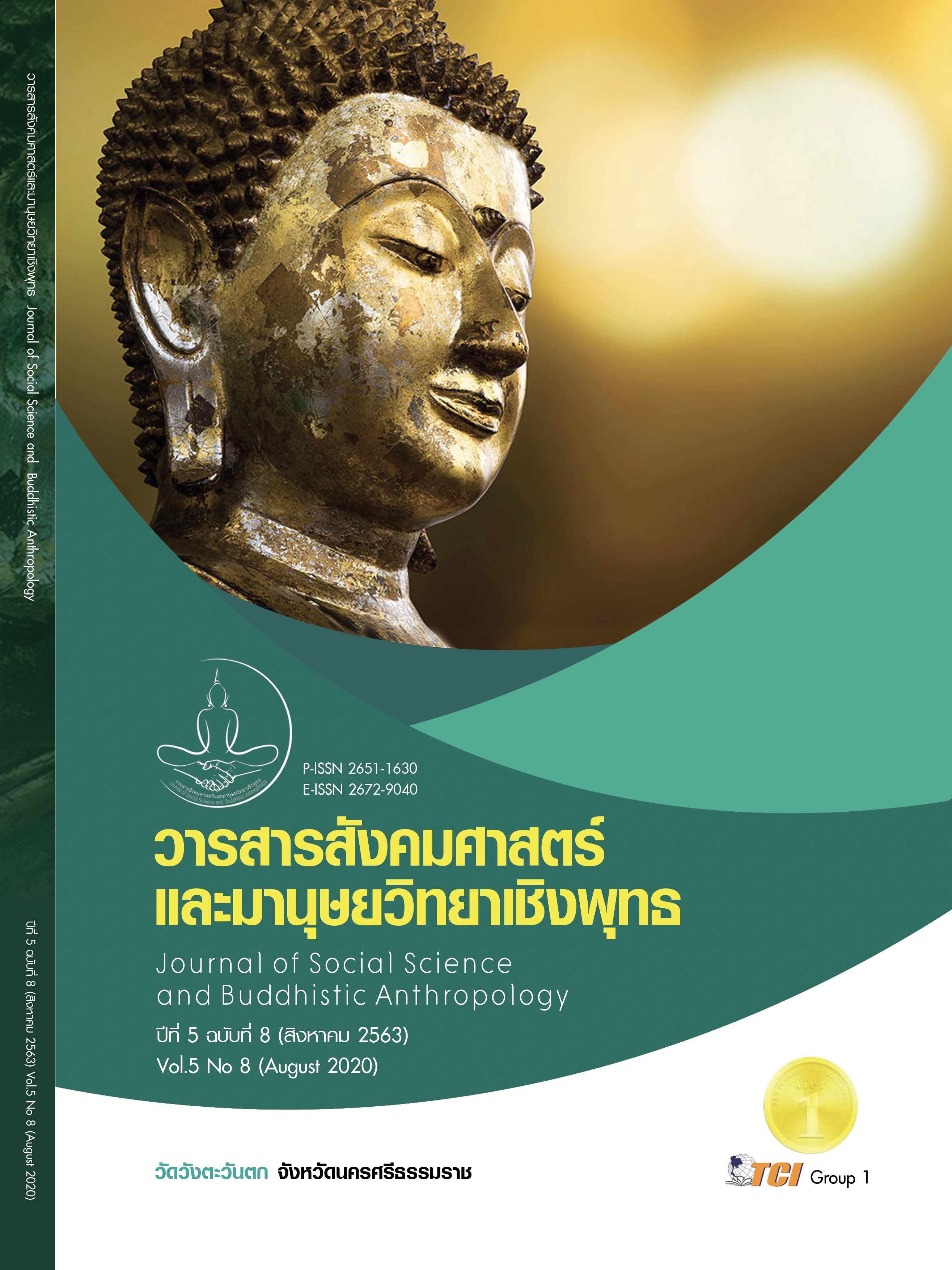MODEL OF COMMUNITY NETWORK MANAGEMENT FOR FOOD SECURITY
Keywords:
Model, Community Network Management, Food SecurityAbstract
This article is intended: 1) to study the community network management process. 2) To study the factors, success conditions, problems and obstacles of community network management. And 3) to develop the community network management model. This was mixed methods research by Multisite Multi-case research process with 3 phases. Phase 1 the current state of the management process and questionnaires. By involved in community network management and food security total of 100 communities. Phase 2 the management process and factors, success conditions, problems and obstacles. By structured interview is a prototype community, consisting of 4 communities. And phase 3 management elements by questionnaires is a scholar of 10 persons. Use statistics, percentage, average and standard deviation. By analyzing the content and summarizing. The results of research are found as follows: 1) the management process is Aware of problems and consciousness forming a network, relationship development, treatment and continuity, create mutual covenants and management. 2) The factors, success conditions, problems and obstacles is: 1. The conditions of success are: 1) internal conditions, namely food resource base problems, awareness, change leadership, benefits, incentives, data management, activities and continuous development. 2) The external factor is the support from agencies. And 2. problems and obstacles include: 1) Internal factors are unfavorable community environments, economic status, ideas and personal beliefs, lack of new knowledge, and participate in budget activities. 2) External factors are government policy. The influence of social flows and values from outside the community. And 3) model of the community network management there are steps: 1) awareness, awareness and understanding of problems, 2) analysis of situations, 3) management, 4) development and adaptation, 5) maintaining continuity and expansion of the group, and 6) elements: (1) members/leaders, (2) goals/ objectives/ benefits, (3) activities, (4) management, (5) public relations/communication, and (6) capital.
References
โกวิทย์ พวงงาม. (2553). การจัดการตนเองของชุมชน. กรุงเทพมหานคร: เอ็กเปอเน็ต.
ชาวบ้านคนที่ 1. (2562). รูปแบบการจัดการเครือข่ายชุมชนเพื่อความมั่นคงทางอาหาร. (นฤมล ดำอ่อน และไชยยศ ไพวิทยศิริธรรม, ผู้สัมภาษณ์)
ชาวบ้านคนที่ 5. (2562). รูปแบบการจัดการเครือข่ายชุมชนเพื่อความมั่นคงทางอาหาร. (นฤมล ดำอ่อนและไชยยศ ไพวิทยศิริธรรม, ผู้สัมภาษณ์)
ทรงสิริ วิชิรานนท์ และคณะ. (2557). วิถีชีวิตและความมั่นคงทางอาหารท้องถิ่นใต้. วารสารวิชาการและวิจัย มทร.พระนคร สาขาวิทยาศาสตร์และเทคโนโลยี, 8(1), 94-107.
นักวิชาการคนที่ 2. (2562). รูปแบบการจัดการเครือข่ายชุมชนเพื่อความมั่นคงทางอาหาร. (นฤมล ดำอ่อนและไชยยศ ไพวิทยศิริธรรม, ผู้สัมภาษณ์)
บุญชม ศรีสะอาด. (2556). วิธีการทางสถิติสำหรับการวิจัย เล่ม 1 (พิมพ์ครั้งที่ 5). กรุงเทพมหานคร: สุวีริยาการพิมพ์.
ประภาพร ขอไพบูลย์. (2555). การขับเคลื่อน ยุทธศาสตร์ความมั่นคงอาหารจากชุมชนสู่ระดับชาติ. กรุงเทพมหานคร: สำนักงานกองทุนสนับสนุนการสร้างเสริมสุขภาพ (สสส.).
ผู้นำชุมชนคนที่ 1. (2562). รูปแบบการจัดการเครือข่ายชุมชนเพื่อความมั่นคงทางอาหาร. (นฤมล ดำอ่อน และไชยยศ ไพวิทยศิริธรรม, ผู้สัมภาษณ์)
ผู้นำชุมชนคนที่ 4. (2562). รูปแบบการจัดการเครือข่ายชุมชนเพื่อความมั่นคงทางอาหาร. (นฤมล ดำอ่อน และไชยยศ ไพวิทยศิริธรรม, ผู้สัมภาษณ์)
พรทิพย์ ติลกานันท์. (2557). การนำเสนอรูปแบบการเรียนรู้ของชุมชนเพื่อสร้างเสริมความมั่นคงทางอาหาร. ใน ดุษฎีนิพนธ์ครุศาสตรดุษฎีบัณฑิต สาขาวิชาพัฒนศึกษา. จุฬาลงกรณ์มหาวิทยาลัย.
พระดาวเหนือ บุตรสีทา. (2557). การสร้างเครือข่ายและการจัดการเครือข่ายการเผยแผ่พระพุทธศาสนาของชุมชนบ้านพบธรรมนำสุข อำเภอทุ่งเสลี่ยม จังหวัดสุโขทัย. ใน วิทยานืพนธ์ศิลปศาสตรมหาบัณฑิต สาขาการบริหารการพัฒนาสังคม. สถาบันบัณฑิตพัฒนบริหารศาสตร์.
วิรัลพัชร ประเสริฐศักดิ์. (2556). ความมั่นคงทางอาหาร: จากพัฒนาการเกษตรสู่เศรษฐกิจพอเพียง. วารสารการเมืองการปกครอง การจัดการบ้านเมืองที่ดี/นโยบาย, 5(2), 139-149.
วีระศักดิ์ จุลดาลัย และคณะ. (2556). การสร้างกระบวนการมีส่วนร่วมในการกำหนดนโยบายสาธารณะและแผนยุทธศาสตร์ด้านความมั่นคงอาหารระดับชุมชนขององค์การบริหารส่วนตำบลสามผง อำเภอศรีสงคราม จังหวัดนครพนม. กรุงเทพมหานคร: สำนักงานกองทุนสนับสนุนการวิจัย.
ศจินทร์ ประชาสันติ์. (2552). การพัฒนาดัชนีชี้วัดความมั่นคงทางอาหาร. กรุงเทพมหานคร: สำนักงานคณะกรรมการสุขภาพแห่งชาติ (สช.).
สุภา ใยเมือง. (2555). ตัวชี้วัดความมั่นคงทางอาหารระดับชุมชน. นนทบุรี: มูลนิธิชีววิถี.
เสาวลักษณ์ รุ่งตะวันเรืองศรี และคณะ. (2559). การเก็บหาและการใช้ประโยชน์ของป่าในป่าเขาหัวช้าง ตำบลตะโหมด อำเภอตะโหมด จังหวัดพัทลุง. วารสารสงขลานครินทร์ ฉบับสังคมศาสตร์และมนุษยศาสตร์, 14(3), 463-483.
Cronbach, L. J. (1990). Essentials of psychological testing. New York: Harper Collins Publishers.
Krejcie, R. V., & Morgan, D. W. (1970). Determining Sample Size for Research Activities. Educational and Psychological Measurement, 30(3), 607–610.








